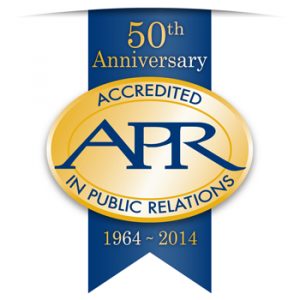 Earlier this year, I presented a workshop on obtaining the Accredited in Public Relations credential to potential candidates sponsored by the Hampton Roads Chapter of the the Public Relations Society of America Professional Development Committee. Earning my APR in 2011, this is a topic I’m passionate about for many reasons. So, when it came time to explain how PRSA was considering changes in the APR to affect how the credential is marketed, earned and distributed, there was certainly some apprehension. I had done the research, though, and kept up with the news from National on the upcoming changes. To my great relief, the news didn’t sway the audience members from their commitment to pursuing the credential, and it shouldn’t sway yours, either.
Earlier this year, I presented a workshop on obtaining the Accredited in Public Relations credential to potential candidates sponsored by the Hampton Roads Chapter of the the Public Relations Society of America Professional Development Committee. Earning my APR in 2011, this is a topic I’m passionate about for many reasons. So, when it came time to explain how PRSA was considering changes in the APR to affect how the credential is marketed, earned and distributed, there was certainly some apprehension. I had done the research, though, and kept up with the news from National on the upcoming changes. To my great relief, the news didn’t sway the audience members from their commitment to pursuing the credential, and it shouldn’t sway yours, either.
What are the changes in APR?
This year the APR celebrates its 50th anniversary. In honor of this milestone, PRSA contracted the Organizational Performance Group in May 2013 to conduct an in-depth study of the value of the credential. After witnessing a decrease in APR-pursuing professionals on average of 256 a year from 1993 to 2002 to 157 a year between 2003 to 2012, the credential was deemed in need of support. Compiling data from personal interviews, focus groups, surveys and content analyses, OPG reported its results to PRSA in August 2013. From the information, OPG has suggested three ways forward to the professional organization:
1. Discontinue the APR
As the APR has witnessed a decline in perception of value in recent years combined with weak promotion of the credential, one of the suggested solutions is for complete discontinuation. Redirecting resources to other professional initiatives, many other professional accreditations have met this fate. PRSA, though, has made it clear that discontinuation is not an option.
2. Focus on Branding
A minimally-invasive treatment, upping the marketing efforts of the APR is the second proposed solution. By providing more resources for promoting the APR and concentrating more on the relationship between PRSA and the Universal Accreditation Board, the sister organization that governs the APR, these changes would marginally help but not fix the problem of decline.
3. Complete Overhaul
The final proposed solution is to totally revamp the APR. With four overarching concentrations, OPG has suggested tactics to 1) increase credibility, such as making the UAB an independent organization, 2) increase value, such as investing in a robust marketing campaign, 3) improve the credential, such as reevaluating the Readiness Review and maintenance requirements, and 4) expanding the credential, such as opening the APR to more than just PRSA members. This recommendation has the most potential in moving the APR forward.
After a two-month open comment period last fall, PRSA announced in December 2013 the creation of a task force co-chaired by Jane Dvorak, APR, Fellow PRSA, and Elizabeth Pecsi, APR, Fellow PRSA. This task force will review the findings of OPG and the open comments to make implementation recommendations to the PRSA National Board. The task force is expected to finalize its suggestions by this summer, and the Board is scheduled to make a final vote in the second half of 2014.
How do the changes in APR affect you?
To be prepared for the questions from the workshop audience, I reached out to Kathy Mulvihill, PRSA APR senior manager, for some clarification. She assured me that candidates that decide to pursue and obtain their APR before 2015, the expected date of implementation of the task force’s recommendations, would be carefully considered. “It is safe to say that if any changes were to be made to the process, we (PRSA) would be fair to all candidates already enrolled.” As I was asked by the workshop candidates if they should even begin their APR journeys before the task force made its recommendations, I felt confident in advising them to do so.
As changes in APR continue to develop, if you have put aside the time and resources to make 2014 the year you commit to the process, don’t let possible uncertainties derail your plans. Until PRSA announces implemented changes, the current APR process will remain in place. Undergoing the current process moved my mindset from that of a tactician to a strategist, helping me to see and navigate the bigger business picture.
Will you make the commitment in 2014 or let the possible changes in APR postpone your plans?



